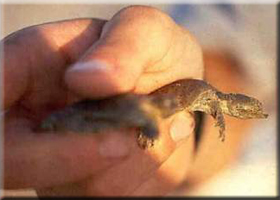

 
|
|
|
|
|
||
|
|

A Place in the Sun
Reaching down through a wire cage, a field researcher carefully handles a newly hatched spiny softshell turtle. After its weight and other data have been noted, the hatchling gets a free ride to the next stage of its life--at the water's edge. If its habitat remains undisturbed, this turtle may live to adulthood. Many of its number, however, haven't been quite that fortunate. 
Softshells use their tube-shaped snouts as snorkels so they can breathe while under water. Spiny softshells need sandy or gravelly shoreline for nesting, but also use the area--often a large rock--to take in the sun. This basking activity is important to researchers because it gives them an opportunity to observe the species more closely. Unfortunately, basking also attracts attention from boaters and cottagers, who may unintentionally disturb a nesting site. The spiny softshell turtle was listed as a threatened species by the Committee on the Status of Endangered Wildlife in Canada in 1991. A recovery team, made up of scientists from Environment Canada, the province and non-governmental organizations, began work a year later to stabilize and increase the size of the population. Although exact numbers are difficult to pinpoint, estimates put 500-1,000 softshells on the Sydenham and Thames rivers in southern Ontario and about the same number in other parts of the province, such as Long Point National Wildlife Area. The species has also been observed in the Ottawa River. Less than 100 are found in the Lake Champlain area of Quebec where recovery efforts are being carried out jointly with the United States. While there is heavy predation of spiny softshell eggs and hatchlings by animals such as raccoons, foxes and coyotes, people are the most significant problem--with one-quarter of the nests at some sites lost due to human disturbance. To help make nesting more productive, recovery team workers install wire cages over the nests after they have been laid from mid-June to July. These cages help prevent interference until the hatchlings are born some time between late August and October. When they hatch, the young are about the size of a two-dollar coin. The male of the species is olive brown with pronounced spots on its shell that are coloured a light tan in the centre. The female does not have such pronounced spotting, but is the larger of the two sexes, growing to slightly larger than a dinner plate--but just as flat. Although their shells are not really soft, they have a leathery feel and not the hard slick surface found on most other kinds of turtle shells. As with many recovery efforts for species at risk, much of the initial work with the spiny softshell focuses on determining the full extent of its habitat, tracking its movement, gathering data on size and general health, and sharing information. So far, the recovery team involved has established that a large part of the threat to this species comes from a loss and degradation of nesting, basking and hibernation sites. Radio transmitters placed on turtles have shown that they can travel distances of up to 30 kilometres in a year, while some move less than half a kilometre. This suggests to researchers that, if all the right habitat elements are present, the turtles won't move far. Further radio tracking in future will help the recovery team determine where the turtles go for the winter, enabling further habitat protection of those areas. Starting with the 1998 nesting season, the recovery team, in cooperation with Environment Canada, has begun studying the role contaminants might play in infertile eggs recovered from hatched or failed nests. In the meantime, efforts continue in working with landowners who have spiny softshells on their property, and in protecting and rehabilitating nesting sites as much as possible. So far, Ontario landowners have been very receptive to habitat protection-an important aspect of any effort to protect species at risk. |
|
|
Home | Air | Atmospheric Science | Climate Change | Environmemental Action | Habitat | Pollution | Species at Risk | Technology | Water | Weather | Wildlife |
|
|
| Help
| Search
| Canada Site |
|
||
|
The Green LaneTM, Environment Canada's World Wide Web site
|
||
|
|
||
|
|
||